Phalangeal Head Resection (Arthroplasty) for Toe Joint Deformities
Surgery Overview
Surgeons often use phalangeal head resection to correct hammer, claw, and mallet toes. In this procedure, the surgeon removes part of one of the toe bones, the phalangeal head, so that the toe can lie flat. The affected tendons are cut and then reattached to conform to the new, correct toe position. A wire or tape holds the straightened toe in place until it has healed.
A variation of this surgery is called implant arthroplasty. It uses an implant made of a material such as silicone to replace the removed bone segment.
Most people have this surgery as an outpatient, so you probably won't have to spend a night away from home. But other things, such as your overall health, may require a hospital stay.
How It Is Done
Phalangeal head resection for hammer toe
Phalangeal head resection for hammer toe: Slide 1
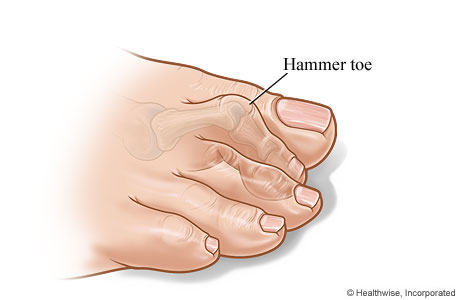
A hammer toe is a toe that bends down toward the floor at the middle toe joint. It usually happens in the second toe. The toe may bend up at the joint where the toe and foot meet, causing the middle toe joint to rise up.
Phalangeal head resection for hammer toe: Slide 2
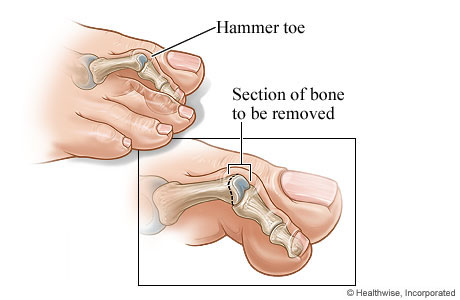
In a phalangeal head resection for a hammer toe, the surgeon removes a section of the phalangeal bone.
Phalangeal head resection for hammer toe: Slide 3
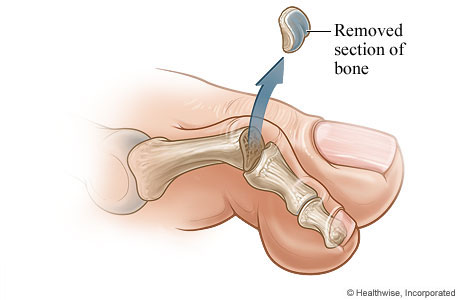
The surgeon removes the bone section.
Phalangeal head resection for hammer toe: Slide 4
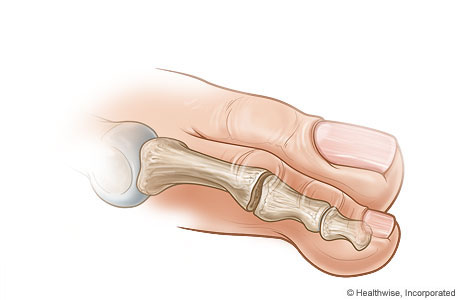
The surgeon straightens the toe.
Phalangeal head resection for hammer toe: Slide 5
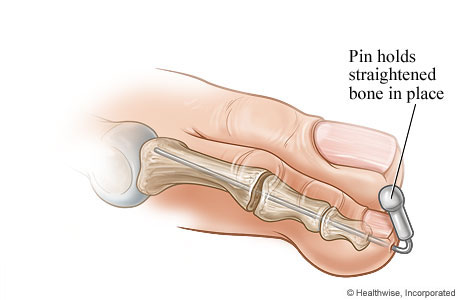
The surgeon uses a pin to hold the straightened hammer toe in place.
Phalangeal head resection for hammer toe: Slide 6
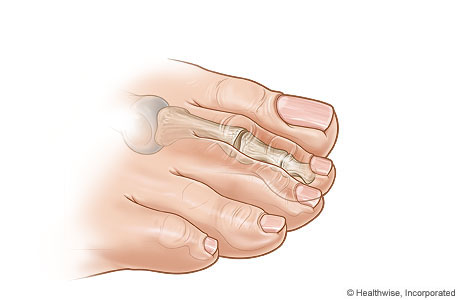
After the toe has healed, the surgeon removes the pin, and the straightened hammer toe stays in place.
What To Expect
The wire or tape that holds the toe in the correct position usually stays in place for 3 to 6 weeks. Your toes may be taped together for 4 more weeks while they adjust to their new positions. You may be able to walk on the affected foot right after surgery, but you might need a special shoe. How soon you can start wearing your own shoes depends on how quickly you recover. You may need a follow-up X-ray.
Why It Is Done
If you have severe pain in a toe that interferes with your daily activities, and if nonsurgical treatments such as roomier footwear, exercises, and pain medicine have not helped, you and your doctor may choose to try a phalangeal head resection.
How Well It Works
The success of surgery for hammer, claw, and mallet toes has not been widely studied. The specific results and risks vary. They depend on the type of surgery, your surgeon's experience, and how severe your deformity is. After surgery, most people have toes that lie flat but don't have normal flexibility.footnote 1
Risks
Possible complications of surgery include:
- Infection, bleeding, and pain, which can occur after any surgery.
- Slow healing.
- Long-term (chronic) swelling of the affected toe.
- Numbness in the affected toe.
- Limited range of motion in the affected toe.
- Risks of anesthesia, such as a change in your blood pressure. Your specific risks depend on the type of anesthesia used, your health, and your response to the medicines used.
- Problems with blood flow in the toes, which may result in losing some or all of the toe. How likely this is depends on how deformed and rigid your toe is.
Credits
Current as of: July 17, 2023
Author: Healthwise Staff
Clinical Review Board
All Healthwise education is reviewed by a team that includes physicians, nurses, advanced practitioners, registered dieticians, and other healthcare professionals.
Current as of: July 17, 2023
Author: Healthwise Staff
Clinical Review Board
All Healthwise education is reviewed by a team that includes physicians, nurses, advanced practitioners, registered dieticians, and other healthcare professionals.


